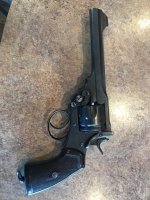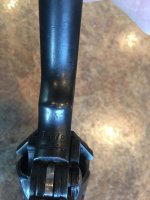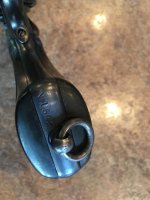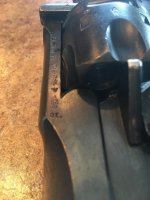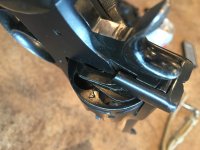I've recently purchased a 1918 Webley MK VI in the original .455 (unshaved cylinder)
I am having some confusion over some of the markings.
The gun has the normal broad arrow and George V crossed penants proof marks as well as the italic "B" inspection marks. Where it gets odd is in the serial number markings.
1. Webleys have 6 digit numeric serial numbers from what I have read
2.The registration certificate says the serial is " 398246 N1578"
3. This gun has "398246" stamped on the underside of the barrel and on the underside of the frame but struck out with a line in both places. The third location Webleys normally have the serial number (the cylinder edge) has "431627" instead of "398246" (I'd guess a replacement cylinder?)
4. "N 1578" is marked on both the underside of the barrel and on the butt strap. I can find no mention of this format being a serial number on any internet site dealing with Webley's. One site suggests the "N" stamp may indication issue to the Royal Navy....perhaps the 1578 is an armoury inventory number?
Don't you wish they could talk?
Anyway, any insight would be appreciated
I am having some confusion over some of the markings.
The gun has the normal broad arrow and George V crossed penants proof marks as well as the italic "B" inspection marks. Where it gets odd is in the serial number markings.
1. Webleys have 6 digit numeric serial numbers from what I have read
2.The registration certificate says the serial is " 398246 N1578"
3. This gun has "398246" stamped on the underside of the barrel and on the underside of the frame but struck out with a line in both places. The third location Webleys normally have the serial number (the cylinder edge) has "431627" instead of "398246" (I'd guess a replacement cylinder?)
4. "N 1578" is marked on both the underside of the barrel and on the butt strap. I can find no mention of this format being a serial number on any internet site dealing with Webley's. One site suggests the "N" stamp may indication issue to the Royal Navy....perhaps the 1578 is an armoury inventory number?
Don't you wish they could talk?
Anyway, any insight would be appreciated
Attachments
Last edited:

